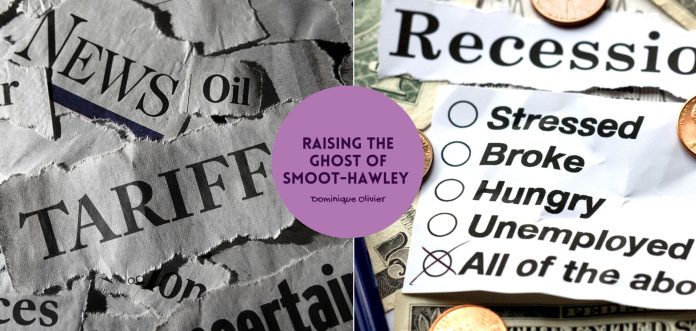We can’t guess where the tariffs and trade war will end up. Instead, we can just revisit the historical parallel. As the saying goes: history doesn’t always repeat itself, but it often rhymes.
Disclaimer, dear reader: I am not, nor will I ever be, an economist. But I’d be lying if I didn’t admit that in the past two weeks, I’ve unintentionally enrolled in a crash course in geopolitics and economics, all thanks to the whirlwind of activity stirred up by US President Donald Trump’s tariffs.
When I pitched the Ghost an article about the tariff situation, he politely suggested that I steer clear of the whole messy business, since neither one of us could weigh in as an expert on this subject. He’s not wrong. Fortunately, I am more experienced in history and storytelling than I am in economics. And boy do I have a story for you.
Against the backdrop of escalating trade tensions and policy reversals, I reckon it’s worth revisiting a historical parallel: the Smoot-Hawley Tariff Act of 1930. This legislation, intended to protect American jobs and farmers during the onset of the Great Depression, instead exacerbated economic woes, leading to retaliatory measures from trading partners and a significant contraction in international trade.
I won’t be so bold as to say that the parallels between then and now serve as a cautionary tale, highlighting the potential unintended (or intended?) consequences of protectionist trade policies. Instead, I’ll simply tell the story and leave you to draw your own conclusions.
The stage is set
By the late 1920s, America was quite literally buzzing. Electrification had swept across the nation, lighting up factories and powering an industrial boom that cranked up productivity like never before. Assembly lines were moving faster, goods were getting cheaper, and the gears of capitalism were whirring with giddy optimism. Add to that the rise of oil refineries and the slow retirement of horses and mules as modes of transportation, and it looked like the US was cooking.
Once motor vehicles took over, a huge chunk of farmland (which had once been reserved to feed all those hardworking horses) was suddenly up for grabs. All that available land, combined with a few thousand enthusiastic farmers, resulted in a surplus of crops that no-one quite knew what to do with. American farms were producing more than ever, but American consumers weren’t buying fast enough to keep up. Real and nominal wages were rising, yes, but not nearly at the pace of productivity. In economic terms, this was great for charts, bad for wallets.
Along came one Senator Reed Smoot, who took one look at the mountain of unsold fruit and veg and figured the solution was simple – the government just needed to nudge Americans back towards spending their money on local produce. In his mind, the best way to achieve this was to slap tariffs on imports. Make the imported stuff more expensive, and surely Americans would have no choice but to buy local. It seemed like a feasible plan on paper, but there was a significant hurdle to success: the US was already exporting more manufactured goods than it was importing, thanks to all those swanky electric factories. In fact, America was running a trade surplus. Manufactured imports were up, sure, but exports were up even more. The real deficit was in food exports, which had been steadily declining. And while food imports were growing, they only added up to about half the value of manufactured imports. The math wasn’t quite mathing.
Then came the famous market crash. By late 1929, the global economy was starting to nosedive, and America’s knee-jerk reaction was to throw up the drawbridge – protect the jobs, protect the farmers, and brace for impact. The Great Depression hadn’t fully landed yet, but the storm clouds were already forming. In trying to shield itself from the world, the US may have just sped up the unraveling.
An ill-advised option
Reed Smoot (Utah Senator, Mormon elder, and tariff enthusiast) teamed up with Willis C. Hawley (Oregon Representative and proud chairman of the House Ways and Means Committee) to cook up one of the most controversial ideas in the annals of economics: the Smoot-Hawley Tariff Act.
It all started with a promise. In his 1928 presidential campaign, Herbert Hoover – Republican golden boy and walking embodiment of technocratic optimism – pledged to raise tariffs on farm goods to protect struggling American farmers. But once he took office, the requests started rolling in. And by “requests,” I mean full-throttle lobbying from every other industry under the sun. Steel, textiles, chemicals – you name it, they wanted in. Why should farmers have all the tariff fun?
Most Republicans were on board. But when the first attempt to push through a tariff hike came up in 1929, it hit a wall put up by a bunch of moderate Republican senators who weren’t quite ready to light the whole trade system on fire.
Then came the stock market crash.
Suddenly, economic panic was in the air, and protectionism started sounding less like a bad idea and more like a lifeboat. So back to Congress the bill went, and this time, it squeaked through the Senate by a razor-thin 44–42 vote. The House of Representatives, always the overachiever in group projects, passed it without much fuss.
Meanwhile, economists across the country collectively facepalmed. In May 1930, more than 1,000 of them signed a petition begging President Hoover to veto the bill. Even Thomas Lamont, erstwhile head of J.P. Morgan, reported that he practically got on his knees, begging Hoover to stop the act. But Hoover, ever the engineer, thought he had it all under control. He signed the bill into law on June 17, 1930, comforted by the idea that the president could tweak individual tariffs later if things got messy, up or down by 50%, no big deal.
Spoiler alert: things got messy.
From bad to worse
Grievances started rolling in almost before the ink on Hoover’s signature had dried.
The Smoot-Hawley Tariff Act sent a not-so-subtle message to the rest of the world that America was closing shop. For countries already buckling under the weight of the Great Depression, not to mention the massive tab left behind by World War I, it landed like a gut punch. Germany, in particular, took a hard hit. Already juggling war reparations and a crumbling economy, it suddenly had even fewer ways to earn the foreign currency needed to make payments. As it turns out, it’s tough to pay someone back when they won’t buy anything from you.
America was essentially demanding international debt repayments while simultaneously blocking the very goods those payments would’ve come from. The rest of the world didn’t take it lying down either. Within a short time, 25 countries hit back with their own tariffs, and what followed was essentially a global fit of economic door-slamming. Between 1929 and 1934, world trade collapsed by a staggering 66%. US exports and imports both plummeted. No-one was buying, no-one was selling. Canada took the opportunity to pivot and cozied up to the British Empire at the 1932 British Empire Economic Conference. France and Britain, clearly not amused, started building new trade alliances. Germany, boxed in and unbelievably broke, turned to clearing agreements instead of trade.
Today, economists and historians around the world agree that while the Smoot-Hawley Tariff Act didn’t set off the Great Depression (that was already brewing), it definitely deepened it and extended America’s economic recovery by multiple years. Some historians have even made the argument that by kicking the global economy while it was already down, the Smoot-Hawley Tariff Act helped to translate economic chaos into political chaos. Economic desperation in Germany created the perfect storm for extremist ideologies to thrive, which may have helped clear the runway for Adolf Hitler and set the stage for World War ll.
Turns out, protectionism didn’t protect much.
The spinoff
When Smoot-Hawley passed in 1930, unemployment in the US was already a troubling 8%. The tariff was sold as a fix and a way to protect American jobs. Unfortunately, it achieved the opposite. By 1931, unemployment had doubled to 16%. By 1932, it hit 25%.
Now, to be fair, not all of that can be pinned on the tariff. As we’ve established, the Great Depression had already begun, thanks to a toxic brew of financial recklessness, plummeting demand, and a banking system built like a house of cards. But while Smoot-Hawley didn’t start the fire, it definitely poured gasoline on it: trade collapsed, farmers were gutted, and export-heavy industries got slammed.
By 1932, the Democrats ran on a promise to rip up the tariff playbook. And after Roosevelt won, he and the newly Democratic Congress passed the Reciprocal Trade Agreements Act of 1934. Suddenly, the president and not Congress had the power to negotiate tariff cuts, country by country. No need for a two-thirds Senate vote, just a regular majority. It happened so quickly that you might have missed it if you blinked, but it was a seismic shift in who controlled US trade policy.
And that shift has stuck. Fast forward nearly a century, and Donald Trump was out on the campaign trail saying he could slap tariffs on other countries without Congressional sign-off. And he wasn’t wrong – he was just taking full advantage of the powers handed down through decades of tariff delegation. If you’ve been asking yourself why it feels like one man is able to make and break the world economy with the stroke of a pen these days, well, there’s part of your answer. The ghost of Smoot-Hawley may be in the room with us right now.
About the author: Dominique Olivier

Dominique Olivier is the founder of human.writer, where she uses her love of storytelling and ideation to help brands solve problems.
She is a weekly columnist in Ghost Mail and collaborates with The Finance Ghost on Ghost Mail Weekender, a Sunday publication designed to help you be more interesting. She now also writes a regular column for Daily Maverick.
Dominique can be reached on LinkedIn here.





Another great article.Thank you!
Thanks so much for reading Daniël!
Truly fully hey shoo wow! Dominique this is fascinating reading. It would appear that Americans have shot themselves in the foot before. Trump is the fool doing it again.
Officially one of my top 5 comments – thanks Mike! I’m glad you enjoyed reading this one
Great article. Very informative!
Thanks so much Craig!